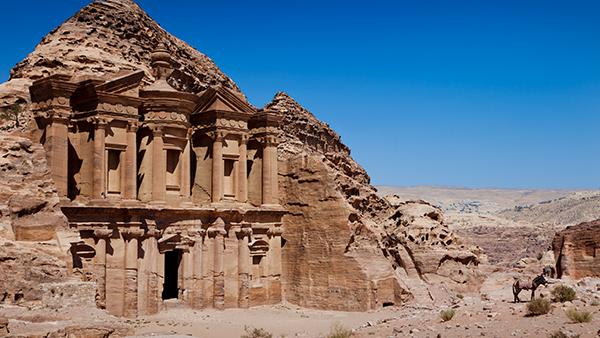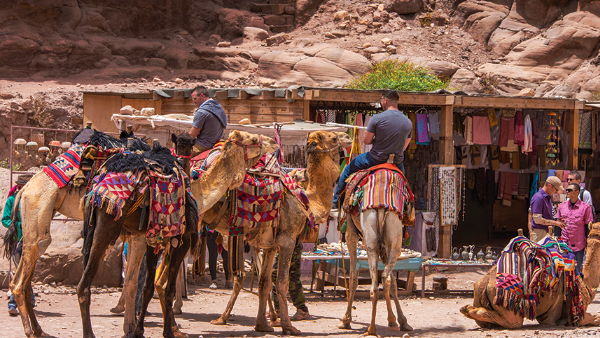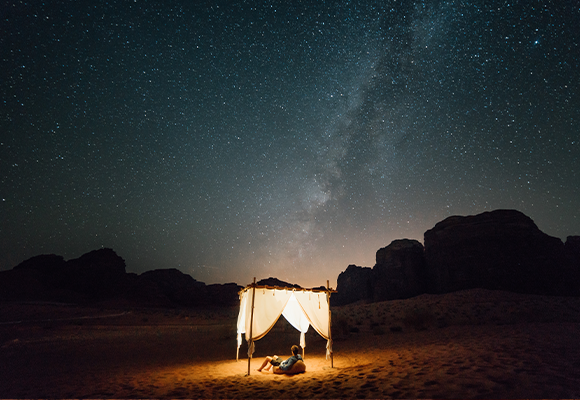Petra
Al Thuraya Travel & Tours
ATTRACTIONS
The ancient city of Petra is one of Jordan’s national treasures and by far its best known tourist attraction. Petra is the legacy of the Nabataeans, an industrious Arab people who settled in southern Jordan more than 2,000 years ago. Admired then for its refined culture, massive architecture and ingenious complex of dams and water channels, Petra is a UNESCO World Heritages Site and one of the new Seven Wonders of the World. Inhabited by the Nabateans, Edomites and Romans, Petra brought together the knowledge and skill of these civilizations to create this world wonder. Caravans laden with incense, silks, spices and other exotic goods would rest at Petra.
al-siq to treasury trail (main trail)
This trail is the most visited trail in Petra, the trail starts from the visitor center of Petra through The Siq to The Treasury. While most tourists think that the trail ends at the ancient city’s main attraction, The Treasury, the main trail continues past the Siq, Royal Tombs, Colonnaded Street and ends by Qasr Al-Bint (The Girl’s Palace).
Duration: This depends on the pace of the tourist but can take up to an hour from the visitors’ center to the Treasury.
Level: Easy


petra museum
Located at the main tourist street and only three minute walk from the main gate to Petra. Opening Times are seven days a week throughout the year from 8:30am until 7:30pm
It contains 280 artifacts, dating back to different ages, the exhibition consists of five halls showing the history of Petra and information about the nabatean’s life and their civilization.
petra kitchen – cooking lessons
The Petra Kitchen enriches Petra visitors’ experiences by offering nightly cooking classes and dinners, sharing authentic local cuisine in a casual, family atmosphere. Visitors work alongside local chefs to prepare dishes found on a typical family’s menu using fresh local ingredients. By sharing recipes and flavors the people of Petra are presenting their history and culture to visitors and encouraging guests to return home to share the tastes of Jordan with friends and family. Guests who join for a multi-night cuisine course will share in food sourcing at the local markets and preparation with the chef to learn how dishes are assembled, from the earth to the plate.


al-khubtha trail
This trail starts from the Visitors’ Center and takes you into the ancient city of Petra through the Siq and past some magnificent monuments. This includes what is known as the ‘street of facades’, as well as a theater craved out of the rock, after which you will explore the intricately carved ‘royal tombs’, which include the Urn Tomb, Silk Tomb, Corinthian Tomb and Palace Tomb, before reaching Al-Khubtha High Place and Cistern to enjoy the breathtaking view.
The trail takes around 4 -5 hours to complete
Difficulty: Hard
ad-deir main trail
This trail begins at the end of the Main Trail, from the museum inside Petra, which is located next to The Basin restaurant. It leads you northwards up ancient steps and after a short walk you reach the Lion Triclinium, which is set in a small side wadi on the left. Continue past this up the carved stairway to reach a hermitage with chambers excavated in the rock and decorated with many carved crosses. You then move on upwards to reach Ad Deir, which lies a short way beyond and offers a fantastic view over the area.
This trail can be self-guided.
Difficulty: Moderate


ad-deir back route
This trail takes you off the main track to reach Ad-Deir, or the Monastery, via a back road route. The trail begins at Kharrubat al-Fajja, which is 50 meters west of the main road to Beidha, and ends at Ad-Deir. The beginning of this trail is easy, allowing you to enjoy the beautiful landscape of the area and the mountain views overlooking Wadi Araba as you walk. It also takes you through an agricultural area. Donkeys can be used for the round trip, taking you from the starting point to the beginning of the steps that lead to Ad-Deir and back again.
From the visitor center you can go by car or bus to the beginning of this trail, which starts at a site that is just off the main road leading to Beidha.
Duration: 4-5 hours
Level: Hard
Guided only
henna fantasia show
Henna Fantasia is a daily activity “show” in Petra at the Grand Hall of the Old Village Resort. Experience the folklore dances performed by Henna men and women, each dance will have its own unique customs and accessories giving the full experience of old traditional folklore. Your dancing skills will be tested at the end of the show.


ad-deir to kharubat al-fajjah
The first part of this trail follows the route of the Main Trail, all the way to Qasr Al-Bint. You then begin an upward climb to the Monastery climbing ancient steps as you pass the Lion Triclinium on the way up to Ad-Deir. Then instead of returning the way you came, this trail takes you past the view point and on to Umm Sysaban, where you will see the remains of an ancient walled settlement. It ends at Kharrubat al-Fajjah, which is located just off the main road leading to Beidha, from where you will need a car or bus to take you back to the visitor center.
Duration: 7-8 hours
Level: Hard
Guided only
beidha – the first trail
This trail begins at Umm Qussa and ends at Slaysel. The starting point is 40 meters to the west of the main road to Beidha. The beginning of the trail is easy and takes you to Bir al-Arayis, one of the many ancient Nabataean water cisterns found in the area. The trail then leads to Siq al-Barid where you will see one of the most beautiful mural paintings in Petra. From there you will move on to the Neolithic Village of Beidha, and then continue walking through Wadi Slaysel until you reach Slaysel itself, where you will be able to enjoy a wonderful view over Wadi Araba.
Duration: 2.5 – 3 hours
Level: Moderate
Guided Only


petra by night
To visit Petra during daylight is awe-inspiring; to experience it at night by the light of 1,800 candles is truly out-of-this-world! Walk through the Siq to the Treasury (Al-Khazneh) following a candle-lit path and enjoy the haunting music of the Bedouins at the Treasury. Tours start at 8.30pm and finish at 10.00pm every Monday, Wednesday and Thursday. Allow yourself plenty of time to walk through the Siq – you don’t want to miss the show!
beidha – the second trail
This trail begins at the Beidha Neolithic Village, near to Siq Al-Barid, which is the largest Nabataean site in Beidha. A few services are available here, including toilets, soft drinks and a parking area. You can reach the Siq Umm al-‘Alda entrance by car or bus and then hike to the Baja Neolithic site, which is 30 minutes walking distance away. You will pass some magnificent rock structures on your way to Baja. After exploring the site you follow the same track back to Siq Umm al-‘Alda and then drive to Shkarat Msaied, which is 15 minutes away from Siq Umm al-‘Alda by road. On your way to Shkarat Msaied, driving along Namala road, you can take in the beautiful surrounding landscape and mountains covered with juniper, oak, and wild pistachio trees. Beyond Namala Road you will experience the ancient Nabataean, Roman, Byzantine, and Islamic caravan route, which descends to Wadi Araba and Bir Madhkur and continues on to the Negeb and Gaza, forming part of the main caravan route that connected Petra with Gaza on the Mediterranean. Nowadays, this road is used to connect Petra with Wadi Feynan, the Dead Sea in the north, and Aqaba in the south.
Duration: 4 – 4.5 hours
Level: Moderate
Guided Only


astronomical tour in petra
A Jordanian archeologist and astronomer, specialized in the history of Petra and the Nabatean civilization, has been doing his research about Petra – his home land – over the last 20 years to introduce the real history of Petra through new theories that are based on science and modern studies. This is an experience that is guaranteed to blow your mind by showcasing the greatness of one of the most unique civilizations in history.
ammarin bedouin camp
The Ammarin Bedouin Camp is a sustainable community development project. a combination of history, nature, heritage and culture in one of the most beautiful areas in Jordan.
Any stay at this camp founded and owned by the local Bedouin promises living heritage and impact in the shadow of Petra.

al-siq to treasury trail (main trail)
One of the most visited trails in Petra, starting from Petra’s Visitor Center, through the Siq to The Treasury. While most tourists think that the trail ends at the ancient city’s main attraction, The Treasury, the main trail continues past the Siq, passing by the Royal Tombs, Colonnaded Street, and ends by Qasr Al-Bint (The Girl’s Palace).
Duration: This depends on the pace of the tourist but can take up to an hour from the visitors’ center to the Treasury.
Level: Easy

al-khubtha trail
This trail starts from the Visitors’ Center and takes you into the ancient city of Petra through the Siq and past some magnificent monuments. This includes what is known as the ‘street of facades’, as well as a theater craved out of the rock, after which you will explore the intricately carved ‘royal tombs’, which include the Urn Tomb, Silk Tomb, Corinthian Tomb and Palace Tomb, before reaching Al-Khubtha High Place and Cistern to enjoy the breathtaking view.
The trail takes around 4 -5 hours to complete
Difficulty: Hard


petra by night
To visit Petra during daylight is awe-inspiring; to experience it at night by the light of 1,800 candles is truly out-of-this-world! Walk through the Siq to the Treasury (Al-Khazneh) following a candle-lit path and enjoy the soul-stirring music of the Bedouins at the Treasury. Tours start at 8.30pm and finish at 10.00pm every Monday, Wednesday and Thursday. Allow yourself plenty of time to walk through the Siq – you don’t want to miss the show!
ad-deir main trail
This trail begins at the end of the Main Trail, from the museum inside Petra, which is located next to The Basin restaurant. It leads you northwards up ancient steps and after a short walk you reach the Lion Triclinium, which is set in a small side wadi on the left. Continue past this up the carved stairway to reach a hermitage with chambers excavated in the rock and decorated with many carved crosses. You then move on upwards to reach Ad Deir, which lies a short way beyond and offers a fantastic view over the area.
This trail can be self-guided.
Difficulty: Moderate
ad-deir back route
This trail takes you off the main track to reach Ad-Deir, or the Monastery, via a back road route. The trail begins at Kharubat al-Fajjah, which is 50 meters west of the main road to Beidha, and ends at Ad-Deir. The beginning of this trail is easy, allowing you to enjoy the beautiful landscape of the area and the mountain views overlooking Wadi Araba as you walk. It also takes you through an agricultural area. Donkeys can be used for the round trip, taking you from the starting point to the beginning of the steps that lead to Ad-Deir and back again.
From the visitor center you can go by car or bus to the beginning of this trail, which starts at a site that is just off the main road leading to Beidha.
Duration: 4-5 hours
Level: Hard
Guided only
ad-deir to kharubat al-fajjah
The first part of this trail follows the route of the Main Trail, all the way to Qasr Al-Bint. You then begin an upward climb to the Monastery climbing ancient steps as you pass the Lion Triclinium on the way up to Ad-Deir. Then instead of returning the way you came, this trail takes you past the view point and on to Umm Sysaban, where you will see the remains of an ancient walled settlement. It ends at Kharrubat al-Fajjah, which is located just off the main road leading to Beidha, from where you will need a car or bus to take you back to the visitor center.
Duration: 7-8 hours
Level: Hard
Guided only
beidha – the first trail
This trail begins at Umm Qussa and ends at Slaysel. The starting point is 40 meters to the west of the main road to Beidha. The beginning of the trail is easy and takes you to Bir al-Arayis, one of the many ancient Nabataean water cisterns found in the area. The trail then leads to Siq al-Barid where you will see one of the most beautiful mural paintings in Petra. From there you will move on to the Neolithic Village of Beidha, and then continue walking through Wadi Slaysel until you reach Slaysel itself, where you will be able to enjoy a wonderful view over Wadi Araba.
Duration: 2.5 – 3 hours
Level: Moderate
Guided Only
beidha – the second trail
This trail begins at the Beidha Neolithic Village, near to Siq Al-Barid, which is the largest Nabataean site in Beidha. A few services are available here, including toilets, soft drinks and a parking area. You can reach the Siq Umm al-‘Alda entrance by car or bus and then hike to the Baja Neolithic site, which is 30 minutes walking distance away. You will pass some magnificent rock structures on your way to Baja. After exploring the site you follow the same track back to Siq Umm al-‘Alda and then drive to Shkarat Msaied, which is 15 minutes away from Siq Umm al-‘Alda by road. On your way to Shkarat Msaied, driving along Namala road, you can take in the beautiful surrounding landscape and mountains covered with juniper, oak, and wild pistachio trees. Beyond Namala Road you will experience the ancient Nabataean, Roman, Byzantine, and Islamic caravan route, which descends to Wadi Araba and Bir Madhkur and continues on to the Negeb and Gaza, forming part of the main caravan route that connected Petra with Gaza on the Mediterranean. Nowadays, this road is used to connect Petra with Wadi Feynan, the Dead Sea in the north, and Aqaba in the south.
Duration: 4 – 4.5 hours
Level: Moderate
Guided Only

dana to petra
Dana to Petra
A truly awe-inspiring section of the Jordan Train and named by National Geographic as one of the 15 best hikes in the world. The trail descends the hilltop village of Dana into Wadi Feynan and onto the dramatic mountain plateaus of Wadi Araba. This region crosses several climate zones, diverse ecosystems, hidden canyons, and dramatic labyrinths of hills and valleys displaying the full spectrum of the region’s geology. The scenery spans from majestic and epic mountaintops to peaceful, fertile farmlands with new landscapes presenting themselves every few kilometres. This section’s most dramatic and memorable aspect is the departure at the Nabatean masterpiece, Petra. A chance to enter the city through the ‘back door’ to walk in the footsteps of ancient traders. Few other trails can boast a site as spectacular as Petra.
Total Length: 72.6 KM
Days: 4 Hiking days
Main sites in the region:
– Dana Biosphere Reserve
– Feynan ruins and ancient copper mines
– Feynan ecolodge
– Hidden stream and waterfall in Wadi Feid
– Little Petra
– Petra, Nabatean capital and wonder of the world


petra to wadi rum
Petra to Wadi Rum
Connecting the two legendary sites of Petra and Wadi Rum is a week-long trek across one of the longest stretches of wilderness on the Jordan Trail. Here in the empty but striking desert, with its dramatic rock formations, stargazing and peace are found at their best. Starting with deep, rugged wadis and moving into open, sandy plains, this section of the trail takes you deep into the places where humans seldom go. Finishing at Wadi Rum village offers a taste of Bedouin life after the remoteness of this section.
Total Length: 125.4 KM
Days: 6 Hiking days
Main sites in the region:
– Petra
– Jabal Haroun (mountaintop burial place of Aaron, off-route)
– Humeima, ancient and Umayyad ruins
– Sandstone mountain “islands” in a sea of sand
– Wadi Rum, Jabal Rum, and Jabal Um Ishrin

